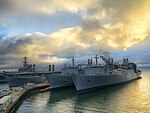Almanac Beer Company
American companies established in 2010Beer and breweries in the San Francisco Bay AreaBeer brewing companies based in the San Francisco Bay AreaCompanies based in San FranciscoFood and drink companies established in 2010
Almanac Beer Company is an Alameda, California brewer that makes farm-to-table beers in small batches using fruit, grains and herbs purchased from local family farms. The company has brewed both year-round table beers and special releases, as well as beers set aside from larger batches and aged in oak barrels. Almanac is best known for its oak-aged sours and farmhouse ales.
Excerpt from the Wikipedia article Almanac Beer Company (License: CC BY-SA 3.0, Authors).Almanac Beer Company
West Tower Avenue,
Geographical coordinates (GPS) Address Nearby Places Show on map
Geographical coordinates (GPS)
| Latitude | Longitude |
|---|---|
| N 37.7831738 ° | E -122.298559 ° |
Address
Almanac Barrel House & Admiral Maltings
West Tower Avenue 651
94501
California, United States
Open on Google Maps








